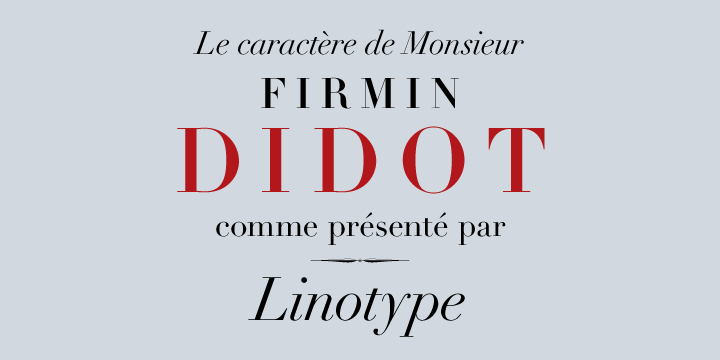

In 1912, Deberny + Peignot, bought the original punches of Didot, making the font newly accessible to designers.

An Italian foundry, Nebiolo, issued a new cut of Bodoni in 1901, and ten years later the largest American foundry, ATF, issued its own very popular cut of Bodoni. After fading from view, Bodoni and Didot made a comeback in the early twentieth century, partly because their geometric clarity seemed modern again. A second and not minor value is to be gained from sharpness and definition, neatness and finish.’ Bodoni’s prescription would be equally at home in a classical treatise on type, or in a 1950s book on proper grooming for debutantes.ĭidot and Bodoni dominated printing until the late nineteenth century, when the Arts and Crafts movement returned to the solidity of humanist letterforms and the texture of Renaissance printing (William Morris called Bodoni’s letterforms ‘shatteringly hideous’). Bodoni described the ‘beauties of type’ as ‘conformity without ambiguity, variety without dissonance, and equality and symmetry without confusion. Bodoni and Didot exaggerated the height and verticality of the ascenders and descenders of the letterforms, lending the characters an architectural grandeur. The result is abstraction and precision, echoing their Enlightenment origins. The late eighteenth- and early nineteenth-century typefaces of the Frenchman Firmin Didot and the Italian Giambattista Bodoni are classified as modern because they introduced an extreme contrast between thick and thin elements, achieving a radical consistency among letter shapes by subjecting the variety of the alphabet to a thick / thin autocracy. Over the twentieth century, carrying into the present, one can observe competing aesthetics of modernity, traceable through different uses of the ‘modern’ typefaces of Didot and Bodoni and the ‘avant-garde’ aesthetic of sans serif grotesques. This phenomenon is observable in the arena of fashion, where serif and sans serif tyefaces have articulated a certain landscape among fashion magazines and fashion brands. Such patterns of use can become so pronounced that they shape our understanding of typography. ‘What is so feminine about Optima?’ he asks, as he wonders whether these gendered associations inhere in the forms of the typeface, or evolve from patterns of use. He checks his work against the competition by making a trip to the drugstore and discovers that Almay, L’Oréal, Revlon, Cover Girl and Maybelline follow an almost uniform typographic code, most sharing the stylistic root of the typeface Optima: he knew the ‘right’ typeface before he realised he knew it. After working to produce an appropriately ‘feminine’ logotype he arrives at a high-contrast sans serif that intuitively feels right. Type designer Tobias Frere-Jones once recounted his experience developing a logo for a company that produced hair products, false nails and perfume. Yet, as typefaces and lettering are employed in related contexts, the associations of these contexts bleed into our understanding of the typeface itself. Barring letters that have an overt figurative origin (characters made of branches or rope), the domain of typography and lettering is refreshingly content-free, a matter of style, history and functionality. His brother, Pierre, published the lavish Louvre Editions, a collection of beautifully illustrated books meant not just to be read but also enjoyed as works of art Firmin created the Didot font to be used in those very books.Typefaces are abstract.

Designed by Firmin Didot, a member of the famous French publishing family, the typeface was meant to evoke luxury and art.

Historyĭidot is the first Modern typeface, and while created more than 200 years ago (between 1784–1811), the typeface remains as elegant and defined as the day it was created. To get a better sense of the typeface, I started by delving into the history of the typeface to see how it was originally used, what made its anatomy unique, and how the typeface is used presently. The landing page had to capture the personality of the typeface, along with appropriate call to actions (CTA) to encourage downloads from a target market that I came up with from the research. The first project of the course was to create a desktop landing page for a typeface - in my case, I was assigned the classic Didot.


 0 kommentar(er)
0 kommentar(er)
